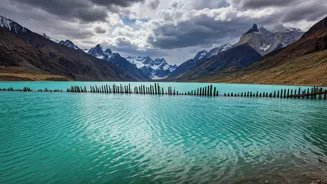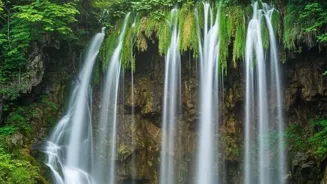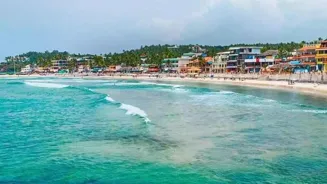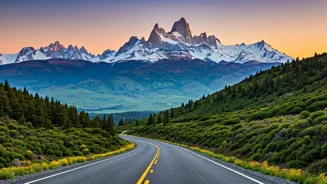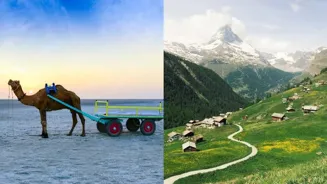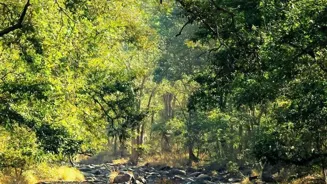Skeleton Lake: Roopkund
Roopkund, nestled in the Himalayas, is known as the Skeleton Lake. This lake is famous for containing hundreds of human skeletons. The discovery of these
remains, found at an altitude of 5,029 meters (16,499 feet), sparked numerous investigations. Initially, theories suggested the skeletons belonged to Japanese soldiers, but radiocarbon dating later revealed that the remains dated back to the 9th century AD. The skeletons belonged to a group of people who died due to a sudden hailstorm. The precise cause of their death still presents a mystery, fueling many speculations regarding the identity and circumstances of their demise, making this location one of India’s most intriguing enigmas.
Magnetic Hill: Ladakh's Mystery
In Ladakh, the Magnetic Hill challenges the laws of physics. This spot has the peculiar characteristic of seemingly pulling cars uphill, even when the engine is turned off. The optical illusion is a result of the surrounding terrain and the positioning of the road. The layout of the area creates the impression that vehicles are rolling uphill. The phenomenon continues to fascinate travelers, making it a favored destination for tourists seeking an unusual experience. Despite ongoing scrutiny, no conclusive scientific explanation has completely demystified this magnetic anomaly, which maintains its reputation as a unique geographical curiosity.
The Hanging Pillar
The Lepakshi Temple in Andhra Pradesh is a marvel, including a pillar that hangs without touching the ground. The temple, which dates back to the 16th century, is dedicated to Lord Shiva, Lord Vishnu, and Lord Veerabhadra. Out of the seventy pillars in the temple, one specifically doesn’t touch the ground. This suspended pillar has captivated tourists and engineers alike for centuries. The mystery around it involves the lack of understanding of how it manages to stay balanced. It's a true test to defy gravity, becoming a focus of structural mystery for generations, thus preserving its place among India’s enigmatic locations.
Jatinga: Bird Suicides
Jatinga, a village in Assam, is infamous for a very strange phenomenon: bird suicide. During the monsoon months, particularly from September to October, migratory birds mysteriously crash to their deaths. The birds arrive at dusk, usually during foggy or overcast conditions, and fly erratically, eventually plummeting. This occurrence has sparked numerous theories, including atmospheric conditions and magnetic disturbances. Scientists have yet to uncover a definitive reason, making Jatinga one of India's most perplexing locations. This enigmatic behavior continues, generating both scientific and local interest, enhancing Jatinga's appeal as a spot of mystery.
Karni Mata Temple: Rats!
The Karni Mata Temple in Rajasthan, also known as the Rat Temple, is home to thousands of rats. The rodents are revered, and devotees believe the rats are reincarnated family members. The temple provides the rats with a protected existence, with food and water provided by the devotees. The presence of so many rats presents a unique religious custom, and it's one of the most unusual features of the site. Visitors travel there to experience the unusual atmosphere and interact with the rats. They also come to absorb a piece of the unique culture where rodents are treated with reverence, adding to its mystique.
Kongka La Pass: UFO Sightings
Located in the Himalayas, near the disputed border of India and China, Kongka La Pass is known for its unexplained UFO sightings. Numerous accounts by locals and travelers report seeing strange lights and unusual aerial activities. The remoteness and high altitude of the location further heighten the mysterious nature of these sightings. Some theories suggest this area could be a base for extraterrestrial activities, or a portal for something more. No substantial proof supports the UFO claims. The area continues to be a site of high interest for enthusiasts looking for the unexplained, keeping its reputation as a center for mystery in India.
Living Root Bridges
The living root bridges in Meghalaya are remarkable structures grown by the Khasi and Jaintia tribes. These bridges are made by guiding the roots of living trees across rivers and streams. The roots intertwine and grow, creating strong and enduring bridges. The process can take several years to complete. The finished bridges are quite strong, sometimes supporting the weight of multiple people. This is an amazing example of how humans interact with nature, offering a sustainable solution for transportation and the environment. It stands as an extraordinary wonder of nature, revealing the power of human ingenuity and environmental harmony.
The Shani Shingnapur Temple
In Maharashtra, the Shani Shingnapur temple is famous for its lack of doors or locks. The residents have a strong faith in Lord Shani, and they believe he protects their homes and property from theft. The belief is so strong that houses, shops, and even banks in the village have no doors. The village is often cited as one of the safest places in India. It reflects strong faith and community trust, making this a fascinating cultural and religious spot. The extraordinary story of the village illustrates the powerful impacts of spiritual belief systems on a community’s daily lives.
Nidhivan: Krishna’s Raslila
Nidhivan in Vrindavan is believed to be the location where Lord Krishna performs Raslila, his divine dance, with the Gopis. The forest is considered sacred. People say it becomes deserted at night. The tales are that the trees transform into Gopis. According to legend, anyone who tries to watch the Raslila is blinded or goes mad. The site is known for its spiritual significance and the strong cultural practices that surround it. The place offers a unique and immersive experience, reflecting the deep-seated faith and cultural practices of the region. The Nidhivan offers a sense of mystery, making it a place of devotion for many devotees.
The Kodinhi Twins Village
Kodinhi, a village in Kerala, is known for its exceptionally high rate of twin births. The occurrence of twin births is so significant that the village has earned the nickname 'Twin Town'. Although several theories exist, including genetic and environmental factors, the specific reasons behind the high rate of twin births in Kodinhi remain unknown. Researchers continue to study the village to find out the cause. The unusual occurrence keeps scientists and researchers interested in the village. It continues to be a subject of research, attracting attention from all over the globe, making Kodinhi a very unique destination.
